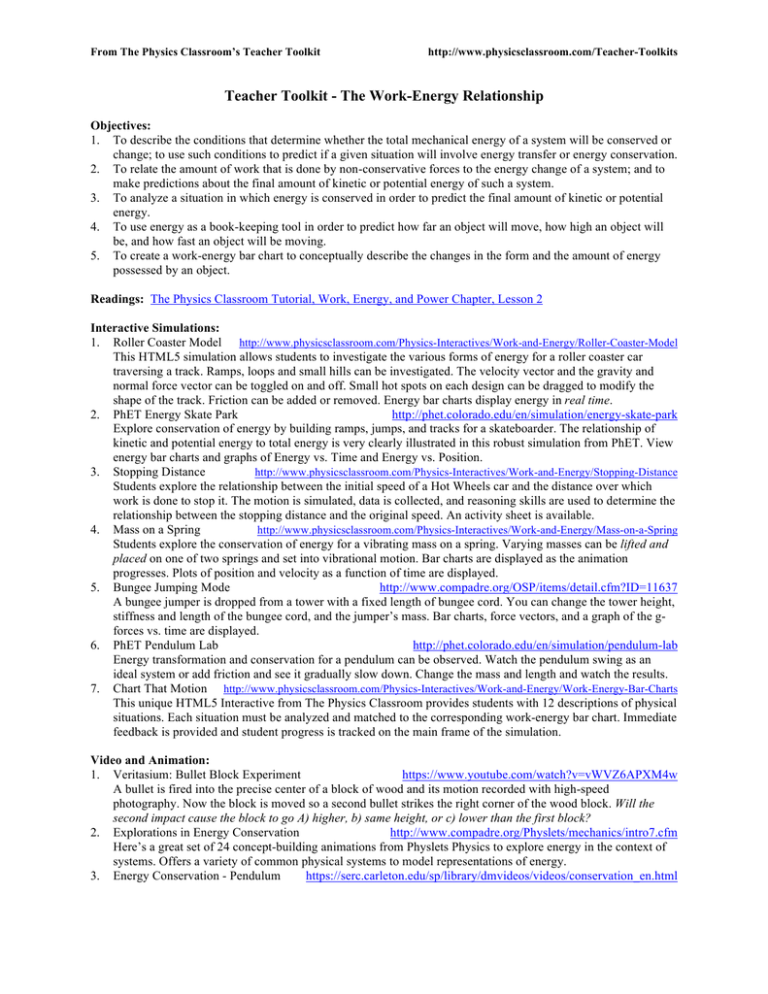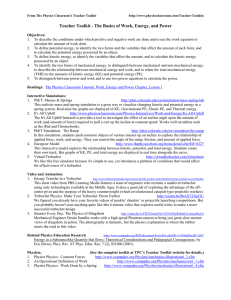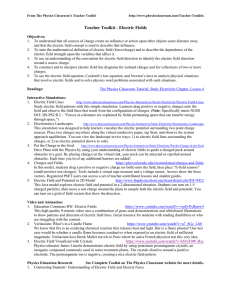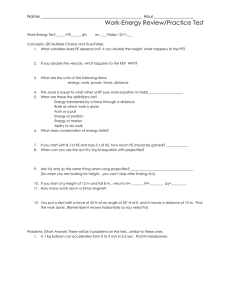
From The Physics Classroom’s Teacher Toolkit
http://www.physicsclassroom.com/Teacher-Toolkits
Teacher Toolkit - The Work-Energy Relationship
Objectives:
1. To describe the conditions that determine whether the total mechanical energy of a system will be conserved or
change; to use such conditions to predict if a given situation will involve energy transfer or energy conservation.
2. To relate the amount of work that is done by non-conservative forces to the energy change of a system; and to
make predictions about the final amount of kinetic or potential energy of such a system.
3. To analyze a situation in which energy is conserved in order to predict the final amount of kinetic or potential
energy.
4. To use energy as a book-keeping tool in order to predict how far an object will move, how high an object will
be, and how fast an object will be moving.
5. To create a work-energy bar chart to conceptually describe the changes in the form and the amount of energy
possessed by an object.
Readings: The Physics Classroom Tutorial, Work, Energy, and Power Chapter, Lesson 2
Interactive Simulations:
1. Roller Coaster Model http://www.physicsclassroom.com/Physics-Interactives/Work-and-Energy/Roller-Coaster-Model
This HTML5 simulation allows students to investigate the various forms of energy for a roller coaster car
traversing a track. Ramps, loops and small hills can be investigated. The velocity vector and the gravity and
normal force vector can be toggled on and off. Small hot spots on each design can be dragged to modify the
shape of the track. Friction can be added or removed. Energy bar charts display energy in real time.
2. PhET Energy Skate Park
http://phet.colorado.edu/en/simulation/energy-skate-park
Explore conservation of energy by building ramps, jumps, and tracks for a skateboarder. The relationship of
kinetic and potential energy to total energy is very clearly illustrated in this robust simulation from PhET. View
energy bar charts and graphs of Energy vs. Time and Energy vs. Position.
3. Stopping Distance
http://www.physicsclassroom.com/Physics-Interactives/Work-and-Energy/Stopping-Distance
Students explore the relationship between the initial speed of a Hot Wheels car and the distance over which
work is done to stop it. The motion is simulated, data is collected, and reasoning skills are used to determine the
relationship between the stopping distance and the original speed. An activity sheet is available.
4. Mass on a Spring
http://www.physicsclassroom.com/Physics-Interactives/Work-and-Energy/Mass-on-a-Spring
Students explore the conservation of energy for a vibrating mass on a spring. Varying masses can be lifted and
placed on one of two springs and set into vibrational motion. Bar charts are displayed as the animation
progresses. Plots of position and velocity as a function of time are displayed.
5. Bungee Jumping Mode
http://www.compadre.org/OSP/items/detail.cfm?ID=11637
A bungee jumper is dropped from a tower with a fixed length of bungee cord. You can change the tower height,
stiffness and length of the bungee cord, and the jumper’s mass. Bar charts, force vectors, and a graph of the gforces vs. time are displayed.
6. PhET Pendulum Lab
http://phet.colorado.edu/en/simulation/pendulum-lab
Energy transformation and conservation for a pendulum can be observed. Watch the pendulum swing as an
ideal system or add friction and see it gradually slow down. Change the mass and length and watch the results.
7. Chart That Motion http://www.physicsclassroom.com/Physics-Interactives/Work-and-Energy/Work-Energy-Bar-Charts
This unique HTML5 Interactive from The Physics Classroom provides students with 12 descriptions of physical
situations. Each situation must be analyzed and matched to the corresponding work-energy bar chart. Immediate
feedback is provided and student progress is tracked on the main frame of the simulation.
Video and Animation:
1. Veritasium: Bullet Block Experiment
https://www.youtube.com/watch?v=vWVZ6APXM4w
A bullet is fired into the precise center of a block of wood and its motion recorded with high-speed
photography. Now the block is moved so a second bullet strikes the right corner of the wood block. Will the
second impact cause the block to go A) higher, b) same height, or c) lower than the first block?
2. Explorations in Energy Conservation
http://www.compadre.org/Physlets/mechanics/intro7.cfm
Here’s a great set of 24 concept-building animations from Physlets Physics to explore energy in the context of
systems. Offers a variety of common physical systems to model representations of energy.
3. Energy Conservation - Pendulum
https://serc.carleton.edu/sp/library/dmvideos/videos/conservation_en.html
4.
5.
This Direct Measurement Video allows students to view the frame-by-frame motion of a pendulum, make
precise measurements of quantities such as position and time, and apply physics concepts.
Spring-Shot Cart
https://serc.carleton.edu/sp/library/dmvideos/videos/conservation_spring.html
This Direct Measurement Video allows students to conduct an analysis of a spring-launched cart.
Inside a Solar Cell
http://www.pbslearningmedia.org/resource/ate10.sci.phys.energy.solarcell/inside-a-solar-cell/
A nicely sequenced interactive that shows how a photovoltaic cell converts solar energy into electricity,
providing a close-up look at each layer of the basic solar panel.
Labs and Investigations:
http://www.physicsclassroom.com/lab/index.html#energy
From the Energy section of The Laboratory at The Physics Classroom website:
1. Work and Kinetic Energy
2. Energy on an Incline Lab
3. Energy of a Pendulum Lab
4. Spring Energy Lab
5. Stopping Distance Lab
Interactive Digital Homework Problems
(See the complete toolkit at TPC’s Teacher Toolkit website.)
1. Mass on a Vertical Spring
2. David Maloney’s Physics Examples: Friction on a Skier
3. Illinois PER Interactive Examples: Block and Spring
Minds On Physics Internet Modules:
http://www.physicsclassroom.com/mop
The Minds On Physics Internet Modules are a collection of interactive questioning modules that target a student’s
conceptual understanding. Each question is accompanied by detailed, question-specific help.
The following assignments are from the Work and Energy modules:
Ass’t WE5 - Conservative and Non-conservative Forces
Ass’t WE6 - Work-Energy Bar Chart Analysis
Ass’t WE7 - Energy Conservation
Ass’t WE8 - Energy Conservation – Math Analysis
Ass’t WE9 - Work and Energy Conversions
Ass’t WE10 - Energy Conversions – Math Analysis
Concept Building Exercises:
http://www.physicsclassroom.com/curriculum/energy
From The Work, Energy, and Power section of The Curriculum Corner
1. Work-Energy Relationships
2. Work-Energy Bar Charts
3. Energy Concept
4. Work-Energy Calculations
Problem-Solving Exercises:
http://www.physicsclassroom.com/calcpad/energy/problems
1. The Calculator Pad, Work, Energy, and Power, Problems #15 - #32
Science Reasoning Activities:
1. Energy on an Inclined Plane
http://www.physicsclassroom.com/reasoning/energy
2. Hot Wheels Stopping Distance
3. Ball-Bat Collision
Real Life Connections:
(See the complete toolkit at TPC’s Teacher Toolkit website.)
1. Wired Physics: Mythbusters Physics Homework – Whips & Pendulums
2. Mr. Rogers IB Physics: Energy Degradation and Power
3. Triboelectric Nanogenerator Harvests Wasted Power
Common Misconceptions
1. Energy is Used Up or Runs Out
(See the complete toolkit at TPC’s Teacher Toolkit website.)
Standards:
A. Next Generation Science Standards (NGSS)
Performance Expectations – Physical Science: Energy (MS-PS3-1, HS-PS3-1, HS-PS3-2)
Disciplinary Core Ideas – Physical Science: Energy - Definitions of Energy (MS.PS3.a.iii, MS.PS3.a.iv,
HS-PS3.a.ii, and HS-PS3.a.iii)
Disciplinary Core Ideas – Physical Science: Energy - Conservationn of Energy/EnergyTransfer (MSPS3.b.i, MS-PS3.c.i, HS-PS3.b.i, HS-PS3.b.ii, and HS-PS3.B.iii)
Disciplinary Core Ideas – Phys. Science: Energy – Energy in Chemical Processes (HS-PS3.D.i andHSPS3.D.ii)
Crosscutting Concepts (Patterns, Cause and Effect, Systems and System Models, Energy and Matter)
Science and Engineering Practices (Practice #2, #3, #5, and #8)
B. Common Core Standards for Mathematics (CC) – Grades 9-12
See the complete toolkit at TPC’s Teacher Toolkit website.
©The Physics Classroom, All Rights Reserved
This document should NOT appear on other websites.



